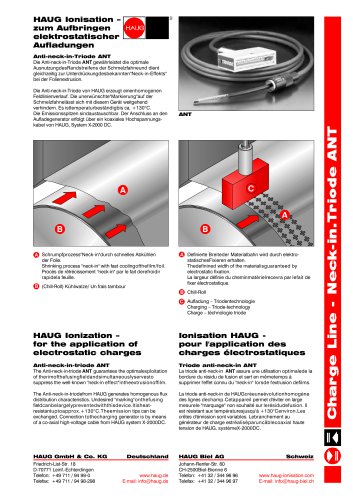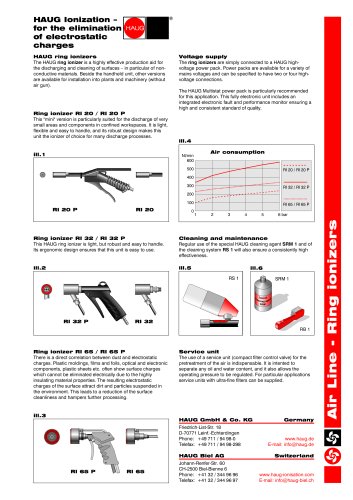
Catalog excerpts

tr.row {} td.cell {} div.block {} div.paragraph {} .font0 { font:10.00pt "Arial Black", sans-serif; } .font1 { font:13.00pt "Arial Black", sans-serif; } .font2 { font:12.00pt "Franklin Gothic Medium", sans-serif; } .font3 { font:6.00pt "Microsoft Sans Serif", sans-serif; } .font4 { font:7.00pt "Microsoft Sans Serif", sans-serif; } .font5 { font:9.00pt "Microsoft Sans Serif", sans-serif; } Electrostatic charging as an interferendce factor during analytical weighing processes Dieter Feller and Karl-Armin Opfer Electrostatic charges At least in theory, the following conceivable possibilities exist for this: To reduce surface resistance levels Օ To reduce contact surfaces To apply separating or distance agents Օ To increase relative humidity To apply antistatic agents Օ To provide reliable earthing Passive or active ionization From thepractical point of view, most of these optionsarenotfeasible when applicable to analytical weighing processes. Every one of us will have had expթrience of electrostatic charging. Either in the form of a mild electric shock when getting out of a car or touching a hand rail, or trying to control unruly "flying hair". These are the usually unwanted effects of electrostatic charging. From thepoint of view of a lab operator involved in weighing processes, this phenomenon couldbe dismissed as an annoyingbuttrivialproblem affecting our private lives, if not for the fact that it causes continual problems when it comes to the process of analytical weighing. Before we turn our attention to solution possibilities, first of all let us take a brief look at the "phenomenon of electrostatic charging". The first findings in this field stretch back to the Greek scientist Thales (640 to 547 BC.), who also made a name for himself in as a mathematician. As long ago as 90 years after the founding of Rome, he discovered that a piece of amber rubbed against his clothing attracted lightweight papyrus particles in the same way as a magnet. The Greek word for amber is "electron"; the word static is derived from Latin and describes a standstill or idle status. So our knowledge about static electricity originates from a long way further than back than our understanding of "electrodynamics", which is more familiar to us as the electrical circuit. Charging phenomena can beseparated into three categories: ͕ charging involving relative mechanical motion of objects and surfaces. charging as a pure contact phenomenon (no relative macroscopic motion occurs). Օ charging as a primarily chemical (or electro-chemical) process. The first category is one of the oldest known forms of charging. As a result of friction, electrons are "released" from the body with the lower discharge energy (donator). They jump over to the body with the higher dischargeenergy (acceptor). As a result, ions are created which charge the body either negatively (in case of an excess of electrons) or positively (in case of a deficit of electrons). These charges are temporary, i.e. they aredischarged again as soon as they have the opportunity, for example as a result of earthing. As it is regrettably not possible to create a galvanic earth connection everywhere on the surface of an insulating material, a different solution has to be found. Ifwetaketwoelectricallyneutralatoms... ...asaresultoffrictionanelectronjumps from oneovertotheother... ...socreatingions negative ill.1:Themodelofanatomillustrateselectrontransition.
Open the catalog to page 1
tr.row {} td.cell {} div.block {} div.paragraph {} .font0 { font:13.00pt "Arial Black", sans-serif; } .font1 { font:12.00pt "Microsoft Sans Serif", sans-serif; } Electrostatic charging as an interfrence factor during analytical weighing processes Dieter Feller and Karl-Armin Opfer HAUG GmbH & Co. KG
Open the catalog to page 2
tr.row {} td.cell {} div.block {} div.paragraph {}
Open the catalog to page 3
tr.row {} td.cell {} div.block {} div.paragraph {}
Open the catalog to page 4All HAUG catalogs and technical brochures
-
Ionizing unit NI
2 Pages
-
Ionizing unit LS GK
2 Pages
-
Ionizing unit EI VS
2 Pages
-
Ionizing unit EI VC
2 Pages
-
Ionizing unit EI RN
2 Pages
-
Ionizing unit EI SL
2 Pages
-
Power pack EN 9 Sine
2 Pages
-
Power pack Multistat Plus
2 Pages
-
Power pack Multistat
2 Pages
-
Air Line - Circle Cleaner 01
2 Pages
-
Ionizing unit AJ
2 Pages
-
Ionizing unit BI
2 Pages
-
IML - In Mould Labelling
1 Pages
-
Single cable technology
4 Pages
-
Clean room
2 Pages
-
Tampon print
2 Pages
-
Folding machines
2 Pages
-
Active ionizers
6 Pages
-
Counter electrodes
1 Pages
-
Bar holder
2 Pages
-
System X-2000
2 Pages
-
Cleaning systems RS 1 / RS 2
1 Pages
-
Perforation counter PZ 3
2 Pages
-
Anti-Neck-In-Triode ANT
2 Pages
-
Charging electrode ALW
1 Pages
-
Charging bar ALS
2 Pages
-
Statik-Air 09
2 Pages
-
Statik-Air 08
2 Pages
-
Ionizing air gun RI LG
2 Pages
-
Needle ionizer NI
2 Pages
-
Mini-Jet Ionisator MJ I
2 Pages
-
Air gate KL GK (Uno)
2 Pages
-
Ring ionizer EI RIF
2 Pages
-
Delta blower DA TR
2 Pages
-
Air Knife AK GK
2 Pages
-
One-Point-Ionizer OPI
2 Pages
-
Ionizing bar EI HRN
2 Pages
-
Segment-Ionisator EI Form
2 Pages
-
Power Pack EN 70 / EN 70 LC
2 Pages





















































